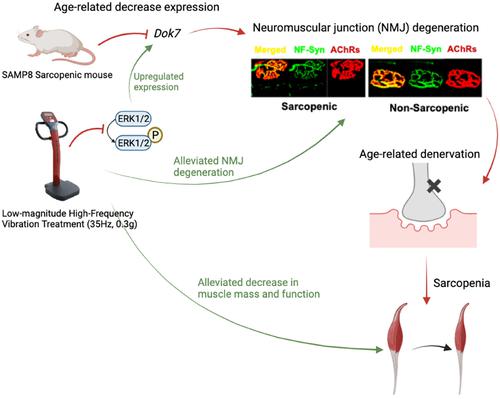当前位置:
X-MOL 学术
›
Aging Cell
›
论文详情
Our official English website, www.x-mol.net, welcomes your feedback! (Note: you will need to create a separate account there.)
Prevention of age‐related neuromuscular junction degeneration in sarcopenia by low‐magnitude high‐frequency vibration
Aging Cell ( IF 7.8 ) Pub Date : 2024-03-27 , DOI: 10.1111/acel.14156 Zhengyuan Bao 1, 2 , Can Cui 1 , Chaoran Liu 1 , Yufeng Long 1 , Ronald Man Yeung Wong 1 , Senlin Chai 1, 2 , Ling Qin 1 , Clinton Rubin 3 , Benjamin Hon Kei Yip 4 , Zhihong Xu 2 , Qing Jiang 2 , Simon Kwoon‐Ho Chow 1, 5 , Wing‐Hoi Cheung 1, 6
Aging Cell ( IF 7.8 ) Pub Date : 2024-03-27 , DOI: 10.1111/acel.14156 Zhengyuan Bao 1, 2 , Can Cui 1 , Chaoran Liu 1 , Yufeng Long 1 , Ronald Man Yeung Wong 1 , Senlin Chai 1, 2 , Ling Qin 1 , Clinton Rubin 3 , Benjamin Hon Kei Yip 4 , Zhihong Xu 2 , Qing Jiang 2 , Simon Kwoon‐Ho Chow 1, 5 , Wing‐Hoi Cheung 1, 6
Affiliation

|
Neuromuscular junction (NMJ) degeneration is one of pathological factors of sarcopenia. Low‐magnitude high‐frequency vibration (LMHFV) was reported effective in alleviating the sarcopenia progress. However, no previous study has investigated treatment effects of LMHFV targeting NMJ degeneration in sarcopenia. We first compared morphological differences of NMJ between sarcopenic and non‐sarcopenic subjects, as well as young and old C57BL/6 mice. We then systematically characterized the age‐related degeneration of NMJ in SAMP8 against its control strain, SAMR1 mice, from 3 to 12 months old. We also investigated effects of LMHFV in SAMP8 on the maintenance of NMJ during the onset of sarcopenia with respect to the Agrin‐LRP4‐MuSK‐Dok7 pathway and investigated the mechanism related to ERK1/2 signaling. We observed sarcopenic/old NMJ presented increased acetylcholine receptors (AChRs) cluster fragmentation and discontinuity than non‐sarcopenic/young NMJ. In SAMP8, NMJ degeneration (morphologically at 6 months and functionally at 8 months) was observed associated with the sarcopenia onset (10 months). SAMR1 showed improved NMJ morphology and function compared with SAMP8 at 10 months. Skeletal muscle performance was improved at Month 4 post‐LMHFV treatment. Vibration group presented improved NMJ function at Months 2 and 6 posttreatment, accompanied with alleviated morphological degeneration at Month 4 posttreatment. LMHFV increased Dok7 expression at Month 4 posttreatment. In vitro, LMHFV could promote AChRs clustering in myotubes by increasing Dok7 expression through suppressing ERK1/2 phosphorylation. In conclusion, NMJ degeneration was observed associated with the sarcopenia onset in SAMP8. LMHFV may attenuate NMJ degeneration and sarcopenia progression by increasing Dok7 expression through suppressing ERK1/2 phosphorylation.
中文翻译:

通过低强度高频振动预防肌肉减少症中与年龄相关的神经肌肉接头变性
神经肌肉接头(NMJ)变性是肌肉减少症的病理因素之一。据报道,低强度高频振动(LMHFV)可有效缓解肌肉减少症的进展。然而,之前没有研究探讨 LMHFV 针对肌少症 NMJ 变性的治疗效果。我们首先比较了肌肉减少症和非肌肉减少症受试者以及年轻和年老 C57BL/6 小鼠之间 NMJ 的形态差异。然后,我们系统地表征了 3 至 12 个月大的 SAMP8 对照品系 SAMR1 小鼠中 NMJ 的年龄相关退化。我们还研究了 SAMP8 中的 LMHFV 对肌少症发作期间 Agrin-LRP4-MuSK-Dok7 通路维持 NMJ 的影响,并研究了与 ERK1/2 信号传导相关的机制。我们观察到,与非肌肉减少症/年轻 NMJ 相比,肌肉减少症/老年 NMJ 呈现出更多的乙酰胆碱受体 (AChR) 簇碎片和不连续性。在 SAMP8 中,观察到 NMJ 变性(形态学上在 6 个月时,功能性在 8 个月时)与肌少症发作(10 个月时)相关。 10 个月时,与 SAMP8 相比,SAMR1 显示出 NMJ 形态和功能的改善。 LMHFV 治疗后第 4 个月骨骼肌性能得到改善。振动组在治疗后第 2 个月和第 6 个月表现出 NMJ 功能改善,并在治疗后第 4 个月时形态退化减轻。 LMHFV 在治疗后第 4 个月增加了 Dok7 表达。在体外,LMHFV 可以通过抑制 ERK1/2 磷酸化来增加 Dok7 的表达,从而促进 AChR 在肌管中聚集。总之,在 SAMP8 中观察到 NMJ 变性与肌肉减少症的发生相关。 LMHFV 可能通过抑制 ERK1/2 磷酸化来增加 Dok7 表达,从而减轻 NMJ 变性和肌少症进展。
更新日期:2024-03-27
中文翻译:

通过低强度高频振动预防肌肉减少症中与年龄相关的神经肌肉接头变性
神经肌肉接头(NMJ)变性是肌肉减少症的病理因素之一。据报道,低强度高频振动(LMHFV)可有效缓解肌肉减少症的进展。然而,之前没有研究探讨 LMHFV 针对肌少症 NMJ 变性的治疗效果。我们首先比较了肌肉减少症和非肌肉减少症受试者以及年轻和年老 C57BL/6 小鼠之间 NMJ 的形态差异。然后,我们系统地表征了 3 至 12 个月大的 SAMP8 对照品系 SAMR1 小鼠中 NMJ 的年龄相关退化。我们还研究了 SAMP8 中的 LMHFV 对肌少症发作期间 Agrin-LRP4-MuSK-Dok7 通路维持 NMJ 的影响,并研究了与 ERK1/2 信号传导相关的机制。我们观察到,与非肌肉减少症/年轻 NMJ 相比,肌肉减少症/老年 NMJ 呈现出更多的乙酰胆碱受体 (AChR) 簇碎片和不连续性。在 SAMP8 中,观察到 NMJ 变性(形态学上在 6 个月时,功能性在 8 个月时)与肌少症发作(10 个月时)相关。 10 个月时,与 SAMP8 相比,SAMR1 显示出 NMJ 形态和功能的改善。 LMHFV 治疗后第 4 个月骨骼肌性能得到改善。振动组在治疗后第 2 个月和第 6 个月表现出 NMJ 功能改善,并在治疗后第 4 个月时形态退化减轻。 LMHFV 在治疗后第 4 个月增加了 Dok7 表达。在体外,LMHFV 可以通过抑制 ERK1/2 磷酸化来增加 Dok7 的表达,从而促进 AChR 在肌管中聚集。总之,在 SAMP8 中观察到 NMJ 变性与肌肉减少症的发生相关。 LMHFV 可能通过抑制 ERK1/2 磷酸化来增加 Dok7 表达,从而减轻 NMJ 变性和肌少症进展。



























 京公网安备 11010802027423号
京公网安备 11010802027423号